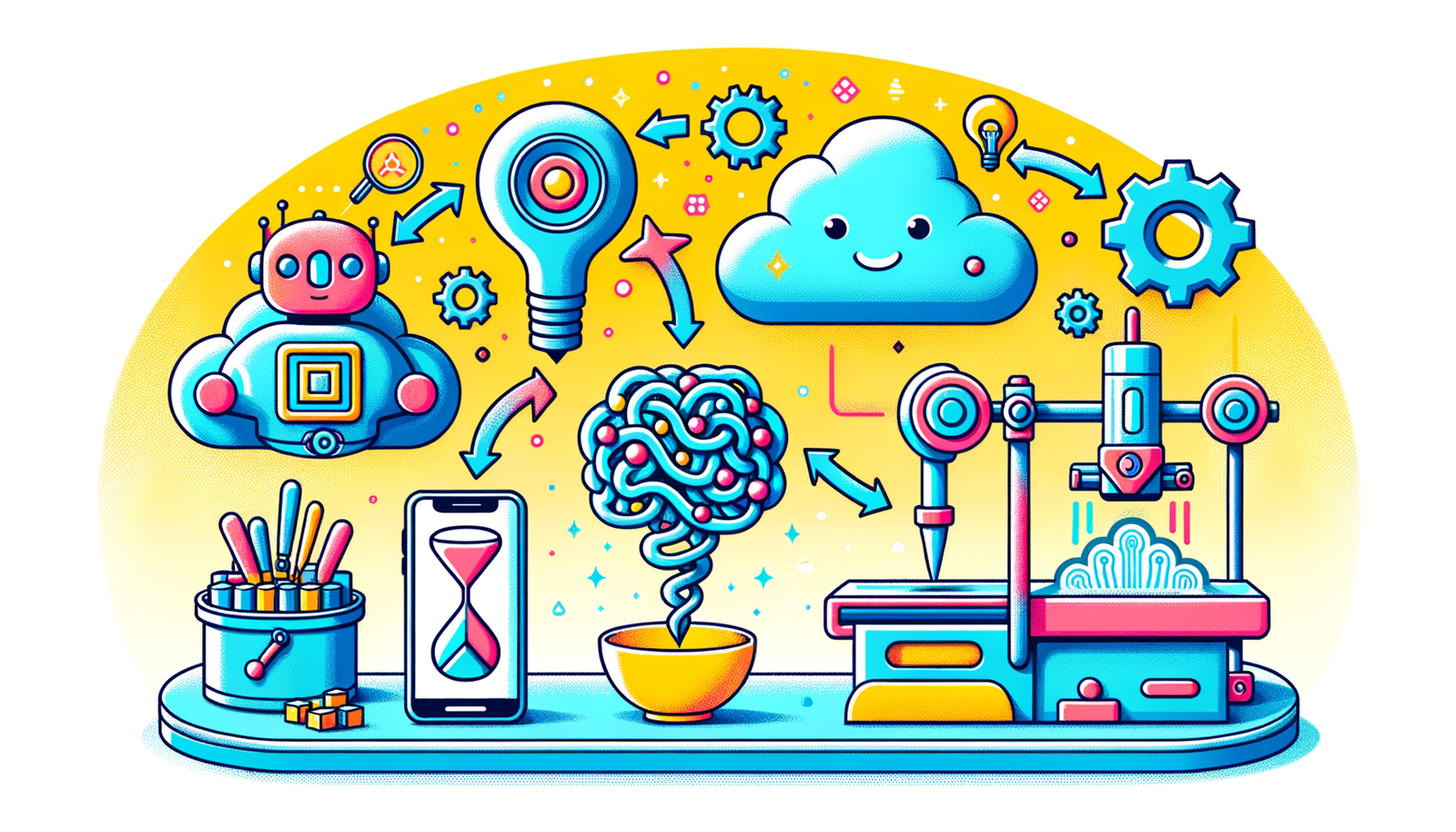Your Cart is Empty
Customer Testimonials
-
"Great customer service. The folks at Novedge were super helpful in navigating a somewhat complicated order including software upgrades and serial numbers in various stages of inactivity. They were friendly and helpful throughout the process.."
Ruben Ruckmark
"Quick & very helpful. We have been using Novedge for years and are very happy with their quick service when we need to make a purchase and excellent support resolving any issues."
Will Woodson
"Scott is the best. He reminds me about subscriptions dates, guides me in the correct direction for updates. He always responds promptly to me. He is literally the reason I continue to work with Novedge and will do so in the future."
Edward Mchugh
"Calvin Lok is “the man”. After my purchase of Sketchup 2021, he called me and provided step-by-step instructions to ease me through difficulties I was having with the setup of my new software."
Mike Borzage
Harnessing AI and Machine Learning for Additive Manufacturing Advancement
February 25, 2025 9 min read


The field of additive manufacturing has witnessed significant advancements in recent years, driven by cutting-edge technologies and innovative software solutions. As industries increasingly adopt additive manufacturing processes, staying abreast of emerging trends in software is crucial for maximizing efficiency, quality, and innovation.
Integration of Artificial Intelligence and Machine Learning
Predictive Maintenance
In the realm of additive manufacturing, equipment reliability is paramount. Unanticipated machinery failures not only disrupt production schedules but also incur substantial financial costs due to downtime and emergency repairs. Traditional maintenance strategies, such as reactive maintenance (fixing equipment after it fails) or preventive maintenance (servicing equipment at scheduled intervals), are no longer sufficient for modern manufacturing environments where efficiency and uptime are critical. This is where artificial intelligence-driven predictive maintenance comes into play.
By utilizing AI to forecast equipment failures, companies can shift from reactive or time-based maintenance to a predictive approach. AI algorithms process vast amounts of data collected from sensors embedded in manufacturing equipment. These sensors monitor multiple variables, including temperature, vibration, noise levels, electrical currents, and other operational parameters. Advanced machine learning models analyze this data to detect patterns and anomalies that may indicate an impending failure.
Implementing predictive maintenance involves several key steps:
- Data Collection: Installing sensors to gather real-time data on equipment performance.
- Data Analysis: Using AI and machine learning algorithms to interpret sensor data and identify warning signs.
- Forecasting: Predicting the remaining useful life of components and scheduling maintenance accordingly.
- Actionable Insights: Providing maintenance teams with precise information on what needs attention and when.
The benefits of predictive maintenance in additive manufacturing are significant:
- Reduced Downtime: Predicting failures before they occur allows maintenance to be scheduled during non-production hours.
- Cost Savings: Avoiding unexpected breakdowns reduces repair costs and prevents loss of production output.
- Extended Equipment Life: Regular, condition-based maintenance can prolong the lifespan of machinery.
- Optimized Maintenance Schedules: Maintenance activities are based on actual equipment condition rather than arbitrary time intervals.
Organizations adopting AI-powered predictive maintenance are positioned to respond proactively to equipment issues, enhancing the reliability of additive manufacturing processes and contributing to a more sustainable and cost-effective production environment.
Process Optimization
Achieving optimal results in additive manufacturing hinges on the precise control of numerous printing parameters. Factors such as print speed, layer thickness, temperature settings, and material flow rates significantly influence the quality of printed parts. Traditionally, determining the ideal combination of these parameters involved extensive trial and error, consuming valuable time and resources. However, with the advent of machine learning, this process has become more efficient and effective.
Machine learning algorithms optimize printing parameters by analyzing extensive datasets from previous print jobs. By examining both successful and unsuccessful prints, these algorithms learn the relationships between parameter settings and print outcomes. This data-driven approach enables the development of predictive models that can suggest optimal settings for new print jobs based on specific design requirements and material characteristics.
Key aspects of machine learning in process optimization include:
- Data Acquisition: Collecting detailed data from each print job, including parameter settings, material properties, and resulting part quality.
- Feature Engineering: Identifying the most influential parameters and understanding how they interact.
- Model Training: Using supervised learning techniques to train models that predict print quality based on parameter inputs.
- Continuous Improvement: Updating models with new data to enhance accuracy over time.
By leveraging machine learning for process optimization, manufacturers can achieve several benefits:
- Enhanced Print Quality: Predictive models suggest parameter settings that minimize defects such as warping or porosity.
- Material Efficiency: Optimized parameters reduce material waste by minimizing failed prints.
- Reduced Setup Time: Quickly identifying optimal settings decreases preparation time for new print jobs.
- Customization: Algorithms tailor parameters for specific materials or designs, enabling complex geometries.
Incorporating machine learning into process optimization empowers additive manufacturing operations to move towards smart manufacturing. By harnessing the power of machine learning, manufacturers can improve current operations and gain a competitive edge by rapidly adapting to new materials, technologies, and market demands.
Design Automation
The integration of artificial intelligence in design processes has revolutionized the way engineers and designers approach product development. AI-driven generative design is an innovative approach that leverages algorithms to create optimized designs based on specified constraints and objectives, such as weight reduction, material strength, and cost efficiency. This method explores a vast design space, generating a multitude of potential solutions that may not be immediately apparent through traditional design techniques.
Key features of AI-driven generative design include:
- Automated Design Generation: AI algorithms generate numerous design iterations based on input parameters.
- Optimization for Multiple Objectives: Designs can be optimized for various criteria simultaneously, such as minimizing weight while maximizing strength.
- Exploration of Novel Geometries: AI can propose unconventional structures that are both functional and efficient.
- Integration with Additive Manufacturing: Generated designs are often complex and well-suited for production through additive manufacturing technologies.
This approach accelerates the design-to-production workflow by:
- Reducing Design Time: Automated generation of design options saves time compared to manual design processes.
- Enhancing Innovation: Designers can explore a broader range of solutions, fostering creativity and innovation.
- Improving Performance: Optimized designs lead to products that perform better and are more efficient.
- Facilitating Customization: Easily adjust design parameters to create customized solutions for specific applications.
For example, in the aerospace industry, components such as brackets and structural supports can be redesigned using generative design to reduce weight without sacrificing strength, leading to significant fuel savings over the lifespan of an aircraft. By implementing AI-driven design automation, the potential for innovation in product development increases significantly, allowing for the creation of components that were previously impossible or impractical to manufacture.
Advanced Simulation and Optimization Tools
Real-Time Simulation
Simulating additive manufacturing processes in real-time is a powerful tool for identifying potential issues before production begins. Real-time simulation allows engineers to visualize how materials will behave during the printing process, predicting defects such as warping, residual stresses, and distortions. By modeling the additive process layer by layer, simulation tools provide insights into the thermal and mechanical interactions that occur during printing.
The benefits of real-time simulation include:
- Reducing Failed Prints: Identifying issues in the virtual environment prevents costly mistakes in physical production.
- Optimizing Process Parameters: Simulations help determine the best settings for temperature, speed, and other critical variables.
- Accelerating Design Iterations: Quickly testing design changes in simulation reduces the time required for prototyping.
- Enhancing Understanding: Visualizing the printing process improves comprehension of complex interactions between materials and machine.
By integrating simulation tools into the design process, manufacturers can enhance the reliability and efficiency of additive manufacturing operations. Real-time simulation enables a proactive approach to problem-solving, allowing potential issues to be addressed before they impact production schedules and budgets.
Topology Optimization
In additive manufacturing, optimizing material distribution for strength and efficiency is crucial. Topology optimization is a computational technique that determines the most effective material layout within a given design space and set of constraints. By focusing material only where it's needed for structural integrity and performance, this method reduces unnecessary weight and material usage.
The process of topology optimization involves:
- Defining Design Objectives: Setting goals such as minimizing weight while maintaining strength or stiffness.
- Applying Constraints: Considering factors like load conditions, material properties, and manufacturing limitations.
- Iterative Computational Analysis: Using algorithms to simulate and refine the design iteratively.
- Generating Optimized Geometry: Producing a design that meets objectives and constraints efficiently.
This approach helps in:
- Reducing Weight: Eliminating excess material without compromising structural integrity, which is particularly valuable in aerospace and automotive industries where weight reduction is critical.
- Enhancing Performance: Optimized designs can improve mechanical performance, such as increased stiffness or better load distribution.
- Enabling Innovative Designs: Creating complex geometries that are often only manufacturable through additive manufacturing.
- Supporting Sustainability: Reducing material consumption contributes to more sustainable manufacturing practices.
By leveraging topology optimization, engineers can create parts that are lighter, stronger, and more efficient than those designed with traditional methods. This leads to products that perform better and contribute to cost savings through material reduction and improved performance.
Thermal and Mechanical Analysis
Assessing thermal effects and mechanical stresses during the additive manufacturing process is essential to ensure the reliability and durability of printed parts. Advanced simulation tools allow engineers to model thermal gradients, residual stresses, and potential deformations that can occur during printing.
Thermal and mechanical analysis provides:
- Insight into Material Behavior: Understanding how materials respond to temperature changes and mechanical loads during and after printing.
- Identification of Potential Failure Points: Predicting areas where stresses may exceed material limits, leading to cracks or distortions.
- Optimization of Support Structures: Designing supports that minimize stress concentrations and thermal gradients.
- Process Parameter Adjustment: Guiding the selection of printing parameters to mitigate undesirable thermal and mechanical effects.
By incorporating these analyses into the design and planning stages, manufacturers can produce parts that meet stringent quality requirements and perform reliably under operational conditions. This proactive approach reduces the risk of part failure in service and enhances customer confidence in additive manufacturing solutions.
Cloud-Based Collaborative Platforms
Remote Collaboration
In today's globalized work environment, the ability for teams to collaborate remotely is invaluable. Cloud-based platforms enable teams to work together from different locations, facilitating real-time sharing and modification of designs. This collaborative approach enhances productivity and innovation by bringing together diverse expertise without geographical limitations.
Key advantages of remote collaboration include:
- Access to Shared Workspaces: Team members can access design files and project data from anywhere with an internet connection.
- Real-Time Updates: Changes made by one team member are immediately reflected, ensuring everyone is working with the latest information.
- Integrated Communication Tools: Messaging, video conferencing, and annotation features streamline communication and feedback.
- Cross-Functional Collaboration: Enables collaboration between different departments such as design, engineering, and manufacturing.
By adopting cloud-based solutions, organizations can harness the collective expertise of their teams, leading to more innovative and efficient project outcomes. This approach also allows companies to tap into global talent pools, collaborating with experts and partners worldwide.
Scalable Resources
Additive manufacturing processes often require significant computational power, especially for complex simulations and optimizations. Leveraging cloud infrastructure for computationally intensive tasks allows organizations to access scalable resources that match their project demands without the need for substantial upfront investment in hardware.
Benefits of scalable cloud resources include:
- Cost-Effectiveness: Pay-as-you-go models reduce capital expenditures associated with high-performance computing systems.
- Flexibility: Resources can be scaled up or down based on project requirements, ensuring efficiency.
- Access to Advanced Tools: Utilize the latest software and computational tools without maintenance overhead.
- Reduced Processing Times: Distribute computations across multiple servers to accelerate simulations and analyses.
Utilizing cloud services ensures that resource limitations do not hinder the progress of additive manufacturing projects. This capability enables smaller organizations to compete with larger counterparts by accessing powerful computational tools that were previously out of reach.
Data Management and Security
With the increasing digitization of manufacturing processes, centralized storage for design files and project data is essential. Cloud-based platforms offer robust data management solutions, ensuring that all team members have access to the necessary information while maintaining high levels of security.
Key aspects of data management and security include:
- Robust Security Measures: Implementing encryption, authentication, and access controls to protect intellectual property.
- Version Control: Tracking changes to maintain design integrity and facilitate collaboration.
- Regular Backups: Preventing data loss through automated backup protocols.
- Compliance: Adhering to industry standards and regulations regarding data protection.
By prioritizing data security and efficient management, organizations can safeguard sensitive information while enhancing collaboration and productivity. This approach builds trust with clients and partners, demonstrating a commitment to protecting valuable intellectual assets.
Enhanced Material Management and Customization
Material Database Expansion
The diversity of materials available for additive manufacturing is rapidly growing. Incorporating a wider range of materials into software libraries provides designers and engineers with detailed material properties for accurate simulations and planning. Comprehensive material databases are essential for leveraging the full potential of new and advanced materials.
Expanding material databases helps in:
- Precise Modeling: Enabling accurate simulations of material behavior during printing and in-service conditions.
- Material Selection: Allowing designers to choose the best material for specific applications based on performance criteria.
- Innovation: Facilitating the exploration of new material combinations and composites.
- Compliance and Standards: Ensuring materials meet industry-specific regulations and quality standards.
By maintaining comprehensive and up-to-date material libraries, software tools empower users to make informed decisions that enhance the performance and quality of printed parts. This capability supports the adoption of emerging materials and technologies in additive manufacturing.
Custom Material Development
Innovation in additive manufacturing is often driven by the development of new materials. Facilitating the creation of bespoke materials tailored to specific applications supports advancements in areas like biocompatible implants, high-performance aerospace components, and customized consumer products.
Software tools can aid custom material development by:
- Simulation of Material Behavior: Predicting how new materials will perform during the printing process and under operational conditions.
- Property Prediction: Estimating mechanical, thermal, and chemical properties of novel material blends.
- Process Optimization: Adjusting printing parameters to accommodate unique material characteristics.
- Supporting Experimentation: Enabling rapid prototyping and testing of materials in a virtual environment before physical trials.
Supporting custom material development expands the possibilities of additive manufacturing, allowing for solutions that meet unique and challenging requirements. This capability drives innovation and offers competitive advantages in specialized markets.
Supply Chain Integration
Efficient material management extends beyond design and simulation. Streamlining material procurement and inventory management ensures that production cycles are not delayed due to material shortages. Integrating supply chain management into additive manufacturing software creates a seamless connection between design, production, and material availability.
Supply chain integration involves:
- Real-Time Inventory Tracking: Monitoring material stocks to anticipate needs.
- Automated Reordering: Setting thresholds that trigger orders when inventory levels reach a certain point.
- Supplier Integration: Connecting with suppliers for quick fulfillment and delivery of materials.
- Cost Optimization: Analyzing procurement data to negotiate better terms and reduce expenses.
By integrating supply chain management, organizations can ensure timely availability of materials, reduce operational delays, and optimize resource allocation. This holistic approach enhances efficiency across the entire production process, from design to final product delivery.
Conclusion
The landscape of additive manufacturing software is rapidly evolving, driven by advancements in artificial intelligence, simulation technologies, cloud computing, and material science. These emerging trends not only enhance the efficiency and quality of the manufacturing process but also open up new possibilities for innovation and customization. As the industry continues to embrace these developments, businesses and designers must stay informed and adapt to leverage the full potential of additive manufacturing technologies. By integrating these advanced software solutions, organizations can position themselves at the forefront of technological innovation, delivering superior products and gaining a competitive edge in the marketplace.
Also in Design News

ZBrush Tip: Enhance ZBrush Workflow with Custom Alphas Created in Photoshop
February 26, 2025 2 min read
Read More
Revit Tip: Optimizing Revit Browser Organization for Enhanced Workflow Efficiency
February 26, 2025 2 min read
Read More
AutoCAD Tip: Optimizing AutoCAD License Management and User Access for Enhanced Productivity
February 26, 2025 2 min read
Read MoreSubscribe
Sign up to get the latest on sales, new releases and more …


